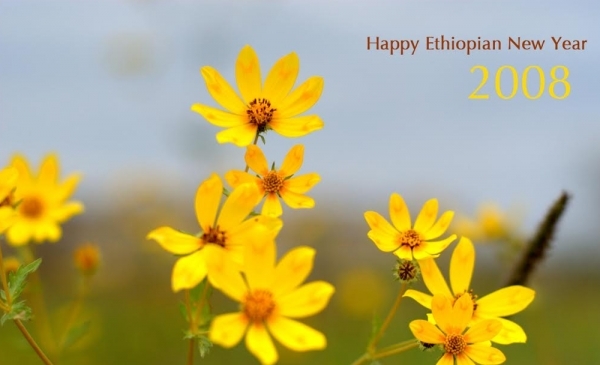Societies around the world developed different calendars, pinning the first day of the year as an astronomical or agriculture event.
Ethiopia, located in the horn of Africa, enjoys not only a favorable climate but also a unique calendar that consists of 13 months. The 13th month contains 5 or 6 days which is generally dependent on whether the year is a leap year or not.
The Ethiopian New Year comes after the rainy season (June-Aug), when nature's beauty can be seen most clearly. The sun comes out to shine all day long, creating an atmosphere of dazzling clarity. Mountains and valleys of the country are all green and with the fresh smell of flowers, including the symbolic yellow daisies which burst out in their entire splendor. This is also the harvest season and therefore a time of parties and celebrations.
The New Year is heralded by young girls signing the song abeba ye hosh meaning do you see the blooming flowers, in their respective villages. While boys give paintings to each household as their new year wishes, adults are expected to respond by rewarding them with small gifts (either bread or money), as a small token in return.
Later in the day, families gather to share a traditional meal of injera (flat bread) and wat (stew). The day of celebration winds down with families visiting friends and relatives, sharing drinks, while children roam around freely and spend their newly received riches.
According to the legend, origins of the New Year festivities are related to the return of the Queen of Sheba (Ethiopia) from her famous visit to King Solomon in Jerusalem. The name "Enkutatash" meaning gifts of jewels, is derived from reports of the Queen of Sheba being welcome back by her chiefs and priests with praises and extravagant gifts of jewels. This joyful holiday has supposedly been celebrated since this time, marked by dancing and singing across the green countryside, budding with spring flowers.
Embracing the modern spirit, residents in the city in recent times have adopted the more western way of sending out greeting cards and partying on New Year’s Eve. September hence, is the month which sees the transition period of the transformation from the old to the new that nestles within it the hopes for a brighter and better future.
Year's end is neither an end nor a beginning but a going on, with all the wisdom that experience can instill in us.”—Hal Borland


